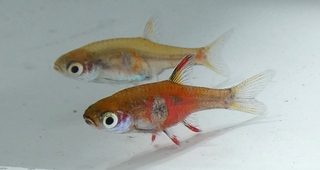
Rasbora is a genus of fish in the family Cyprinidae. They are native to freshwater habitats in South and Southeast Asia, as well as southeast China. A single species, R. gerlachi, is only known from an old specimen that reputedly originated from Africa (Cameroon), but this locality is considered doubtful. They are small, up to 17 cm (6.7 in) long, although most species do not surpass 10 cm (4 in) and many have a dark horizontal stripe.

Microrasbora is a genus of small fishes. The generic name means "small Rasbora", however these are more closely related to the danios than rasboras. They inhabit freshwater in Myanmar and Yunnan, China.

Danio is a genus of small freshwater fish in the family Cyprinidae found in South and Southeast Asia, commonly kept in aquaria. They are generally characterised by a pattern of horizontal stripes, rows of spots or vertical bars. Some species have two pairs of long barbels. Species of this genus consume various small aquatic insects, crustaceans and worms.

The bala shark, also known as the tricolor shark, tricolor sharkminnow, silver shark, or shark minnow, is a fish of the family Cyprinidae, and is one of the two species in the genus Balantiocheilos. This species is not a true shark, but is commonly so called because of its torpedo-shaped body and large fins.

Sundadanio axelrodi is a danionin in the family Cyprinidae, with origin from Borneo, Bangka, and Sumatra. Originally described as a rasbora, Rasbora axelrodi, this tiny species was later deemed to be more closely related to the danios but not enough to be moved into the genus Danio. Sundadanio axelrodi reaches a maximum size of 1.7 cm. Sundadanio was considered monotypic until the genus was reassessed by Conway, Kottelat and Tan in 2011.

Oreoglanis is a genus of fish in the family Sisoridae native to Asia. These fish live in fast-flowing streams in China, mainland Southeast Asia and the Indian subcontinent. They are mainly distributed in the Mekong, upper Salween and Irrawaddy River drainages. They range from the Brahmaputra basin to the Lam River drainage in central Vietnam. They are easily distinguished from other catfishes by their strongly depressed head and body and greatly enlarged paired fins that have been modified to form an adhesive apparatus. The flattened shape of these fish and the large pectoral and pelvic fins provide essential adhesion in the fast-flowing waters they live in.

Balantiocheilos is a small genus of cyprinid fish from southeast Asia. It includes two species.

Schistura is a genus of fish in the stone loach family Nemacheilidae native to the streams and rivers of the southern and eastern Asia. Some of these species are troglobitic.

Danio erythromicron, often known as emerald dwarf danio and emerald dwarf rasbora, is a species of cyprinid fish which is endemic to Inle Lake in Myanmar.

Pangasius is a genus of medium-large to very large shark catfishes native to fresh water in South and Southeast Asia. The term "pangasius" is sometimes used to specifically refer to the commercially important basa fish, P. bocourti.

Epalzeorhynchos is a small ray-finned fish genus of the family Cyprinidae. Its members are – like some other cyprinids – known as "freshwater sharks" or simply "sharks". They are, however, freshwater members of the Osteichthyes lineage which is distinct from the Chondrichthyes lineage of sharks. The description of these animals as "shark" is most likely a reference to the shark-like shape of these popular cyprinids.

Psilorhynchus is a genus of fish in the family Psilorhynchidae native to South Asia. This genus is the only member of its family. The members of Psilorhynchus are small benthic fishes which occur in rivers and streams with fast to swift currents, hence they are often referred to a torrent minnows. They are distributed in southern Asia, in the Indo-Burma region and the Western Ghats.

The dwarf rasbora is a species of ray-finned fish in the genus Boraras, native to freshwater habitats of southeast Asia. It grows to be about 10-20mm long at adulthood,the maximum length can reach 25mm(1 inches).

The least rasbora or exclamation point rasbora is a species of ray-finned fish in the genus Boraras, native to freshwater habitats in mainland southeast Asia. This species is very small, ranging from 12 to 16 mm.

The danionins are a group of small, minnow-type fish belonging to the family Cyprinidae. Species of this group are in the genera clades danio and devario, based on the latest phylo-genetic research by Fang et al in 2009. They are primarily native to the fresh waters of South and Southeast Asia, with fewer species in Africa. Many species are brightly coloured and are available as aquarium fish worldwide. Fishes of the danio clade tend to have horizontal stripes, rows of spots, or vertical bars, and often have long barbels. Species within the devario clade tend to have vertical or horizontal bars, and short, rudimentary barbels, if present at all. All danionins are egg scatterers, and breed in the rainy season in the wild. They are carnivores, living on insects and small crustaceans.

Boraras naevus is a fish in the family Cyprinidae endemic to Thailand. Its locations include swampy areas north of Surat Thani, the Tapi River drainage, and the Andaman Sea slope of the Malay Peninsula near Trang.

Rasbora vulgaris is a species of ray-finned fish in the genus Rasbora. It is a member of the R. paviana-subgroup, which comprises five species from Indochina and the Malay Peninsula
Thryssocypris tonlesapensis is a species of cyprinid of the genus Thryssocypris, described in 1984. It has a maximum length of 6.4 centimetres (2.5 in) among unsexed males and is endemic to the Mekong basin, inhabiting Cambodia and Laos. It has 9-10 dorsal soft rays, 15-16 anal soft rays and 43-44 vertebrae. It is considered harmless to humans and is classified as "least concern" on the IUCN Red List.

















